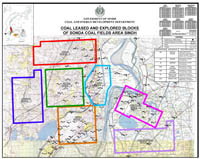Sonda-Jherruk Coalfield
SONDA COAL FIELD
| Distance from Karachi : | 150 Km |
| Total Area : | 1,822 sq. km |
| Identified Area: | – sq. km |
| Coal Reserves: | 7.112 Billion Metric Tons |
Ever since its discovery in 1981 by the Geological Survey of Pakistan, the Sonda coalfield in Thatta district, has been investigated in some detail. Bara Formation which hosts coal beds has an exposed thickness of 9 meters at Dhaduri. Eleven lignitic beds of variable thicknesses were proved within a depth of 144 meters in this Formation. A maximum thickness of the coal seam was encountered in one bore hole at 118 meters depth where it measured 1.3 meters. Two other coal seams were also located, one of 0.5 meter at 80 meters depth and the other 0.78 meter at 84 meters depth. The lower seam has been designated as the Sonda seam.
The coal seams in the upper zone, above the Sonda seam in the geological column are termed as “Dhaduri seams” whereas the name of “Jherruck seams” is assigned to the coal seams falling in the lower coal below the Sonda seam (Ahmad and others, 1986). Three other seams encountered only in hole DH-20 are stratigraphically just above the Sonda coal seam, in the middle coal zone and are named as Inayatabad seam.
The drilling data indicates that in the Sonda coalfield pinching and swelling of the lensoid coal beds are pronounced which make the correlation of seams difficult. The beds are almost horizontal to 2 degrees dipping towards west. The beds plunge gently towards south. The main Sonda coal seam is considered to have a reasonable consistency in its extension, although it could be discontinuous or change to carbonaceous shale, and wash out between the widely spaced drill holes.
Useful Links:
Message:
Chief Minister Sindh
Managing Director TCEB
About Us:
Search:


